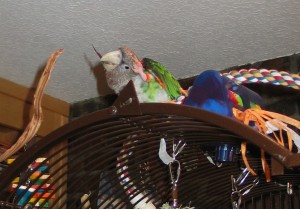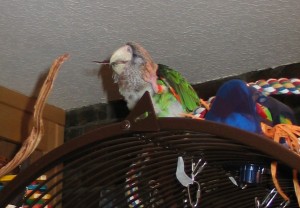On her eponymous reality show, “Sarah Palin’s Alaska,” the former governor of Alaska and her daughter Bristol bond over ‘stunning’ halibuts and gutting them.” There is nothing wrong with showing the public something of the realities of commercial fishing. The Palins once made their living this way. Fishing is the most dangerous of occupations; it’s a tough and arduous life.
However, Palin took the clobbering and killing to a gratuitous level. She was not matter-of-fact about it. Rather, she cheered on the act, spoke about it in repetitive, gory detail, and climbed in herself. Then, like an Aztec priestess, she whipped out the still-beating heart of the Halibut she had beaten and was about to bleed for big Bristol to moo over.
This woman can be a pathetic primitive.
Not so long ago, I read a Times Literary Supplement book review of Jonathan Safran Foer’s “Eating Animals.” His is the first philosophical treatise arguing against eating animals that has captured my attention because of its appeal to logic and fact.
Safran Foer’s conclusion: “We should not – for both moral and prudential reasons – eat animals in the way we now eat them. ‘In the way we now eat them’ denotes their utterly miserable lives in intensive rearing facilities – factory farms, aka CAFOs or Concentrated Animal Feeding Operation – and their horrific deaths at assembly line slaughterhouses.”
Note that this careful philosopher has not said we should not eat animals, but that given what we do to them, we should not eat them. This libertarian writer who had penned a defense of Michael Vick (I & II) has not changed her views on natural rights, but she has become more convinced than ever about our moral and ethical obligation to treat animals kindly.
Arguably, commercial pig farming is crueler than dispatching dogs, then-and-there, as Vick did. These “Babe” look-alikes wallow for ages in their own waste, in pig pens so cramped, the creature cannot even collapse when exhausted. The animal’s skin often ulcerates and its muscles and bones atrophy. Food farming can involve practices such as tail docking, tooth-clipping, “castration, branding, debeaking, and other painful processes.” I solve this ethical problem by patronizing farmers whose animals roam and graze, not by agitating for government to criminalize commercial farmers and hurt the multitudes they feed.
I don’t often eat meat, but when I do, I buy it from my local Natural Markets store, where it is guaranteed to have come from animals that have lived a good life and died painlessly. However, reading this review, we can’t even be sure of the “humane meat” promise:
“Even if the animals we eat had decent lives, which they do not, we would still have to face up to the manner of their deaths: “No jokes here, and no turning away. Let’s say what we mean: animals are bled, skinned, and dismembered while conscious”. Safran Foer is talking specifically about cattle here, but the deaths of other animals differ only in minor details. Typically, cattle are led down a chute to a “knocking box”. Here, theoretically, a steel bolt is shot into the cow’s brain. “Sometimes the bolt only dazes the animal, which either remains conscious or wakes up as it is being ‘processed’.” “Processing” continues with wrapping a chain around the animal’s leg, and hoisting it into the air. Then, it is moved to a “sticker”, who cuts its throat. If the knocking hasn’t done its work, then, as one slaughterhouse worker put it: “They’d be blinking and stretching their necks from side to side, looking around, really frantic”. Then they move on to the “head skinner”, where the skin is peeled off the head of the animal. Some cattle, not the majority but a non-negligible minority, find themselves still conscious at this stage. Then, on to the “leggers”, who cut off the lower portions of the animals’ legs. At this point: “As far as the ones that come back to life \[go\] . . . the cattle just go wild, kicking in every direction”.
It’s pretty obvious, though, that no fisherman has invented a merciful way to kill fish. Sarah Palin should have been sober and mature about what she was partaking in on that commercial fishing boat: “This is how it’s done, it’s not pretty or even merciful, but people have to eat.” Something like that. Instead, she put on a phony, blood-thirsty, eager display that was both inappropriate, creepy, and plain cruel.
UPDATE I (Dec. 13): Palin is wrong so often and on so many fundamental issues it’s hard to know where to begin. Go to the latest news item about her Haitian excursion, and there you’ll find this gormless woman giving it up for more foreign aid. (De-program by reading “YES TO US AID, NO TO USAID.”)
“I know that there’s been some discussion of U.S. aid perhaps being lifted from this area,” she said. “Again — not to get political — but if some of the politicians would come here and see the conditions, perhaps they would see a need for, say, a military airlift to come bring supplies that are so needed here.”
UPDATE II (Dec. 14): Huggs makes a perceptive comment; he is a perceptive, courageous reader, because, unlike so many of my WND readers over the years—he is intellectually curious and has never demanded that a writer confirm his opinions.
JH also nails Sarah: Her strength is in her fabulous persona; her life story, her family, her vigor, her sheer physical loveliness. I’ve always said that it’s a shame she doesn’t hone her expertise—energy issues—and, in matter of politics, listen to Todd more (he was a card-carrying separatist). I’d like to see more of the terrific Todd in her TLS series.


